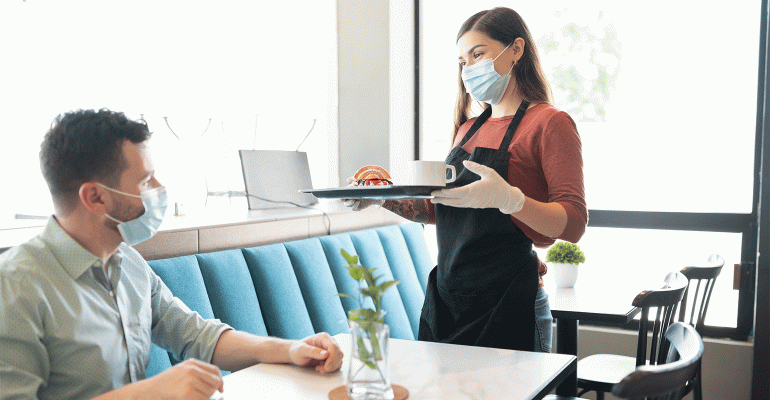After federal health officials on Thursday gave vaccinated people a green light to ditch their face masks and sit closer together, restaurant operators were left with some difficult decisions to make.
The Centers for Disease Control and Prevention updated its guidance to say vaccinated people in most settings no longer have to wear masks or remain socially distant, unless required by regulators.
The guidance comes as the vaccines, now widely available, have proven to be very effective in protecting people from the disease that has killed more than 900,000 over the past 15 months. The move is expected to result in changes to state and local mask and social distancing requirements where they still exist.
But with about two-thirds of the country still unvaccinated, should restaurants continue to require guests and servers to wear masks? Should they ask for proof of vaccination? Is it safe to sit guests closer together?
And what does the Occupational Safety and Health Administration, or OSHA — the agency that actually has oversight over workplace safety — have to say about all this?
Attorneys, industry leaders, state lawmakers and others weighed in on Friday, acknowledging that questions still remain, and that it may take time for the CDC guidelines to be taken up by state and local regulators.
The National Restaurant Association on Friday said it is the process of updating its operating guidance — which currently recommends mask wearing — to reflect the CDC’s language, though officials said the new language was not yet available.
Larry Lynch, the association’s senior vice president of science and industry, said in a statement, “We still have a lot of questions for the CDC about how we need to implement their latest guidance. We are in the process of updating our COVID-19 Operating Guidance where it reflects the CDC’s previous language and after talking with CDC, will determine if other changes are needed.”
Attorney Kevin Troutman, co-chair of law firm Fisher Phillips’ healthcare practice, urged employers to look to OSHA, rather than the CDC, for advice on changing workplace policies. As of Friday, OSHA’s guidance had not been updated since January.
“Thus far, OSHA has said that fully vaccinated workers should not be treated differently than masked workers in terms of COVID protocols,” Troutman said in a statement. “CDC guidance does not override OSHA or state or local rules that are in place. So even though OSHA may take note of CDC guidance, their statements thus far do not dovetail with the CDC. Employers must evaluate all these factors in determining what the guidance means for them.”
In a newsletter outlining some risks and hurdles to consider, Troutman said employers should tread cautiously if asking workers about vaccine status or even requiring vaccination. Workers who are unvaccinated and are required to continue wearing masks or stay physically distant could have a claim for retaliation if they are harassed or discriminated against, for example
And, while OSHA can help with workplace guidance, restaurants are still left with questions about how to handle guests.
Troutman warns that asking guests about vaccination status is a “risky proposition, fraught with legal peril, which can vary by jurisdiction.” His advice: Best to consult with legal counsel.
But even as federal and state officials move closer to lifting pandemic restrictions, restaurant operators may choose to maintain a cautious approach.
Troutman notes that there could be competitive risks: workers may gravitate toward restaurants with looser mask requirements, for example.
On the other hand, servers who deal with the public may prefer a workplace with more safety precautions in place — and so may guests.
Last year, the Aspen Institute’s Food and Society Program created a national Diner Code of Conduct offering guidance on maintaining a safe environment for patrons and guests. The code was developed in partnership with prominent restaurant operators, including José Andrés, as well as the James Beard Foundation, the NRA and Resy.
A key recommendation is requiring mask wearing for both restaurant workers and guests.
In a Washington Post editorial published this week — which was updated after the CDC announced its shift for the vaccinated — authors Corby Kummer, Andrés, Chicago restaurateur Rick Bayless and New York City restaurateur Russell Jackson, reiterated their call for protecting both guests and workers with mask and distancing policies.
“Until there’s a federally verified proof of vaccination or the CDC declares herd immunity, restaurants must prioritize protecting their workers and their guests — and that still means masks indoors, as the CDC recommends for groups that include unvaccinated people,” Kummer said in an email.
Contact Lisa Jennings at [email protected]
Follow her on Twitter: @livetodineout





